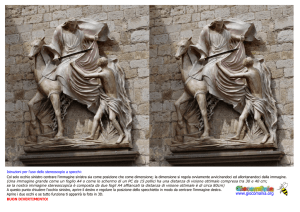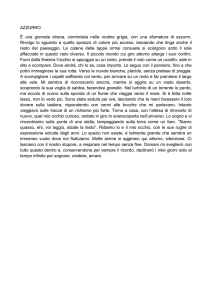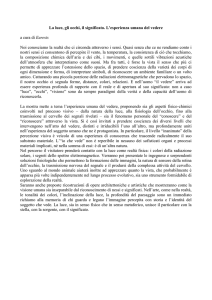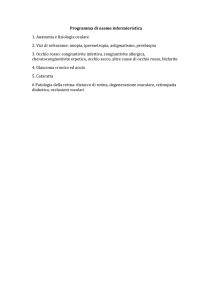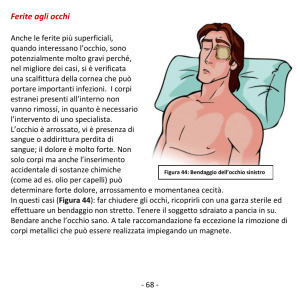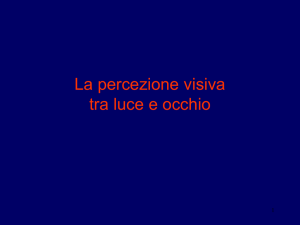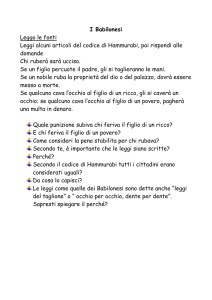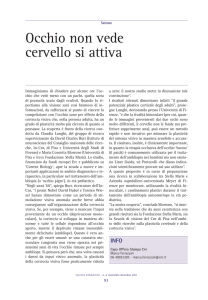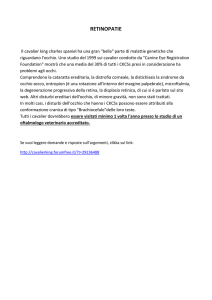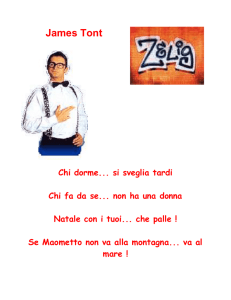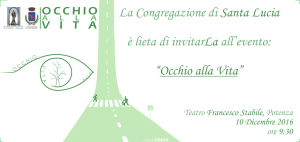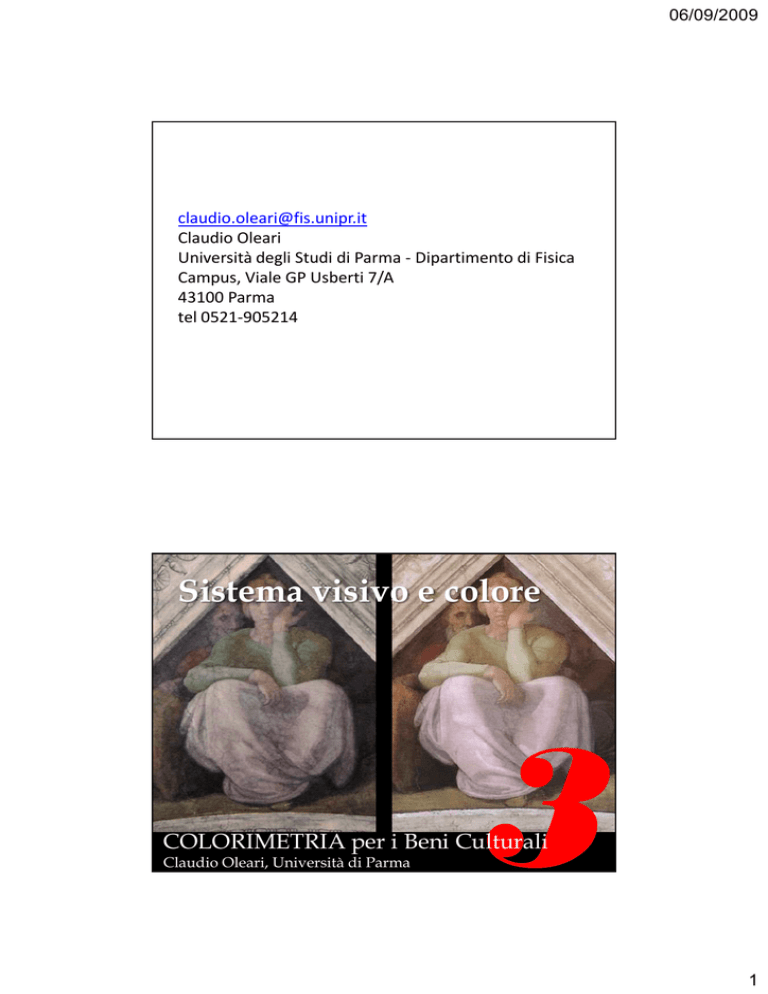
06/09/2009
[email protected]
Claudio Oleari
Università degli Studi di Parma - Dipartimento di Fisica
Campus, Viale GP Usberti 7/A
43100 Parma
tel 0521-905214
Sistema visivo e colore
3
COLORIMETRIA per i Beni Culturali
Claudio Oleari, Università di Parma
1
06/09/2009
Il filtraggio della luce
(il cristallino, la macula, …)
e le opponenze cromatiche
3
6 mesi
8 anni
12 anni
25 anni
47 anni
60 anni
70 anni
82 anni
91 anni
Densità ottica del
cristallino
2
Lerman S., Radiant Energy and the Eye, Macmillan Pub. Co., New York 1980
1
400
500
600
700 [nm]
2
06/09/2009
Macula lutea
Fovea
blind spot/optic nerve
Absorbance of the macula
[arbitrary unit]
MACULA LUTEA
400
nm
500
600
700
Tomografia della fovea
3
06/09/2009
(Disegno di H. Kolb)
segnale analogico
Segnale ad impulsi
luce
(Disegno di H. Kolb)
S
400
M
500
L
600
[nm] 700
luce
4
06/09/2009
(Disegno di H. Kolb)
bastoncelli
coni
Cellule orizzontali
“Center-surround organization”
Cellule bipolari
Cellule amacrine
phasic Magnocellular Cells (antagonismo acromatico)
tonic Parvocellular Cells (opponenza cromatica)
Midged ganglion cells
luce
Koniocellular cells, or KC cells
Dall’occhio al cervello
5
06/09/2009
Genicolato - nodoso
Il nucleo genicolato
laterale è solo un
ripetitore di segnale
e non attua
elaborazione
Cap.3
(Disegno di S. Zeki)
Cap.3
LGN
Nucleo
Ginecolato
Laterale
1
occhio destro, strato parvocellulare
2
occhio sinistro, strato parvocellulare
3
occhio destro, strato parvocellulare
occhio sinistro, strato parvocellulare
4
strato koniocellulare
5
6
occhio sinistro,
strato magnocellulare
occhio destro,
strato magnocellulare
(Foto Hubel)
L’ LGN è solo un ripetitore di segnale e non attua elaborazione
6
06/09/2009
Diagram of the cortex unfolded from one hemisphere of the monkey, showing
identified visual areas. The areas that are colored are recognized as being visual
sensory areas, or areas closely associated with them.
V1 is the primary visual
(striate) cortex, which
receives input from the
lateral geniculate
nucleus.
V1 projects principally to
area V2. Many of these
visual areas contain
topographically
organized maps of the
half of the retina that
sends a projection to the
hemisphere.
(Felleman & Van Essen, 1991)
Visual areas constitute
about half of the
monkey's cortex.
Corresponding areas in
the human cortex
undoubtedly account for
a smaller fraction of the
total.
Cap.3
Cap.3
(Felleman & Van Essen, 1991)
7
06/09/2009
Mappatura tra retina e
corteccia
Cap.3
Mappatura della retina
sulla corteccia V1 e V2
A. Valberg, Light Vision Color, Wiley (2005)
8
06/09/2009
esperimento di Roger Tootell
stimolo al centro del campo visivo
- Osservatore: macaco anestetizzato
l'iniezione di 2-desossiglucosio radioattivo.
- Tempo di osservazione 45’
- Un occhio è chiuso.
Marcatura in un’autoradiografia di una
sezione parallela alla superficie della
corteccia striata (V1) dell'emisfero
sinistro appiattita.
L'aspetto discontinuo delle zone marcate è
dovuto al fatto che solo un occhio è
stimolato, e rappresenta le colonne di
dominanza oculare.
1 cm
Cap.3
Cap.3
Struttura della corteccia visiva V1
D
S
D
S
interno
D
S
esterno
Colonne di dominanza oculare
9
06/09/2009
Sezione della corteccia
visiva (V1)
Colonne di
dominanza
oculare
(Hubel & Wiesel 1974)
occhio destro
occhio sinistro
occhio destro
occhio sinistro
occhio destro
occhio sinistro
interno
↔
esterno
- La corteccia consiste in Colonne
di dominanza oculare.
- Tra i punti di un oggetto osservato
e i punti della corteccia esiste una
corrispondenza biunivoca.
- Lo stato di polarizzazione dei
neuroni a diversa profondità della
corteccia V1 è in funzione
dell’inclinazione della linea
osservata .
10
06/09/2009
Hering illusion
“Subjective Contours” di Kanizsa
Bressan Neon spreading
In V2 esistono cellule che rispondono a linee virtuali.
11
06/09/2009
il cervello e il colore
S.Zeki (Nature, 284, 412 (1980))
Representative action spectra (wavelength selectivities) for
some narrow-band cells of the fourth visual areas (V4) of
monkey cortex. Action spectra were obtained. by using
neutral density filters and determining the minimum intensity
at every wavelength to which there was a respanse. The
upper two spectra show the responses obtained and tbe
manner of 'drawing the curves to determine peak sensitivity
and bandwidth. Arrows indicate there was no response at
the highest intensities available.
Action spectra in discontinuous lines are those of cells
inhibited by light of the relevant wavelengths,
those in continuous lines represent actionspectra of cells
excited by the relevant wavelengths.
12
06/09/2009
L’enigma
13
06/09/2009
Enigma
Isia Leviant
Enigma e PET
When most human subjects view the figure shown in (a) and' fixate the centre, they perceive movement in
the circles. Positron emission tomographic studies (b) show that this perception is correlated with increased
activity in a region of the prestriate visual cortex corresponding largely to area V5 and its immediate vicinity
(regions of highest activity shown in white and red). In (b), (A) shows horizontal slices through the averaged
brain, to indicate the active regions when human subjects looked at a pattern in motion (arrows point to area
V5). (B) shows the regions of the most significant blood flow changes (arrows) when the same human
subjects looked at Enigma.
14

